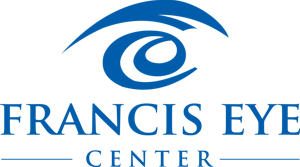Eye Diseases and Disorders
Eye Disease and Disorder Treatments
Vision can be affected by a broad spectrum of eye disorders and diseases. Some problems are benign and do not require treatment. Other problems may cause severe and permanent vision loss if left untreated.
At Francis Eye Center, we are well equipped to address the full spectrum of your eye care needs. Dr. Francis commonly treats the following conditions:
Diabetic Eye Changes:Every person that is diagnosed with diabetes needs to have their eyes checked at least once per year. Diabetes may effect the eye in many different ways, and blurred vision is sometimes the first symptom of diabetes. A comprehensive eye exam may uncover signs of underlying diabetes, and lead to vision-saving, even life-saving, diagnosis and treatment. |
Glaucoma:Glaucoma is an eye disease that causes damage to the optic nerve, which connects the eye to the brain. Glaucoma may develop slowly, and a person with glaucoma may not experience any symptoms. Left untreated, glaucoma may lead to permanent blindness. Treatment to lower the pressure inside of the eye is used to stop the progression of glaucoma, and to preserve eyesight. Glaucoma treatment may include eye drops, laser, or surgery.
|
Macular Degeneration:Age-Related Macular Degeneration (AMD) is an eye disease that involves damage to the macula, which is the area of the retina that is responsible for providing clear vision for seeing fine detail (such as reading) and for color vision. A person with AMD may experience blurred vision, distortion of images (straight lines may appear wavy,) or difficulty reading. If left untreated, AMD may lead to permanent vision loss. A comprehensive exam is necessary to diagnose AMD and to direct treatment in order to preserve eye sight.
|
Amblyopia (lazy eye):Amblyopia is a condition that develops during childhood in which the brain learns to ignore a poorly seeing eye. Symptoms may include blurred vision, an eye that “wanders,” or the child may be asymptomatic while seeing clearly with their unaffected eye. Amblyopia is best treated during childhood, and treatment becomes more difficult and less effective as people become older. Early diagnosis and treatment is key to preventing permanent vision loss due to amblyopia.
|
Conjunctivitis (pink eye):Conjuctivitis is often experienced as red, itchy eyes that often include a discharge that forms as a crust on your eyelashes during the night. “Pink eye” is caused by an infection of the clear membrane that lines your eyelid and eyeball. Treatment can include eye drops and other methods. |
Floaters & Flashes:“Floaters” is a catch-all term for the small dots, flecks, lines or cobwebs that come into your field of vision. They are caused by the shadows of clumps of cells in the eye’s vitreous. Flashes are bright sparks of lights or streaks in your vision. They happen when the vitreous rubs against the retina. Both floaters and flashers are usually harmless and go away on their own; however, they can be signs of a more significant problem (such as retinal detachment), so make an appointment with an ophthalmologist right away if you experience them.
|
Farsighted (hyperopia):Hyperopia is a condition in which the eye must exert extra effort to see clearly. A person with uncorrected hyperopia may see clearly objects at distance, but struggle to see objects at near. People with hyperopia may experience headaches, eye strain, and reading difficulties. Hyperopia may be missed on a basic vision screening, but a comprehensive eye exam will identify hyperopia, which can be treated with eyeglasses, contact lenses, or laser correction.
|
Nearsighted (myopia):Myopia is a refractive eye disorder in which the eyeball is too long or the cornea too curved. It causes people to be able to see close objects clearly, but far objects are blurred. Myopia effects roughly 30% of our population, and it can be treated with eyeglasses, contact lenses, or laser surgery. |
Cataracts:A cataract is a clouding of the lens inside of the eye. This clouding causes decreased vision, which is often experienced as blurred vision, faded or darkened colors, difficulty seeing in the dark, and glare from headlights or street lights. Cataracts occur most often as a result of aging, but they may also result from trauma, other medical conditions, and medications.
|
Astigmatism:Astigmatism in a condition in which the eye focuses light unequally, which may cause blurred vision, eye strain, or headaches. Astigmatism is common and may change over time. Eyeglasses, contact lenses, or surgery may be used to treat astigmatism. |
Presbyopia:The eye is able to change its focus, to see at distance and also to see at near, because the lens inside of the eye changes shape. After 40 years of age, the lens of the eye becomes less pliable and people experience difficulty seeing up close. Presbyopia is treated using reading glasses, bifocals, contact lenses, and sometimes treated with surgery. |
Botox:Botulinum toxin, better known as Botox®, is best known for its cosmetic uses, but it can also be an effective treatment for facial spasms, including eyelid spasms. Ophthalmologists are ideal administrators for Botox, as they are most familiar with the complex muscles around the eyes. |
If you are having problems with your eyes, including pain or blurred vision, we encourage you to make an appointment with Francis Eye Center today.



